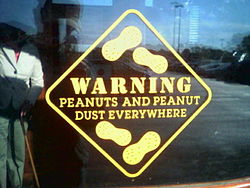Peanut allergy

Editor-In-Chief: Prab R Tumpati, MD
Obesity, Sleep & Internal medicine
Founder, WikiMD Wellnesspedia &
W8MD's medical weight loss NYC, sleep center NYC
Philadelphia medical weight loss and Philadelphia sleep clinics
| Peanut allergy | |
|---|---|

| |
| Synonyms | N/A |
| Pronounce | N/A |
| Specialty | N/A |
| Symptoms | Hives, swelling, anaphylaxis |
| Complications | N/A |
| Onset | Minutes to hours after exposure |
| Duration | Variable |
| Types | N/A |
| Causes | Immune system reaction to peanut proteins |
| Risks | Family history, atopic dermatitis |
| Diagnosis | Skin prick test, blood test for IgE |
| Differential diagnosis | Tree nut allergy, food intolerance |
| Prevention | Avoidance of peanuts |
| Treatment | Epinephrine, antihistamines, corticosteroids |
| Medication | N/A |
| Prognosis | N/A |
| Frequency | ~1-2% of the population |
| Deaths | Rare, but possible due to anaphylaxis |
Peanut Allergy: An Overview[edit]
Peanut allergy is one of the most common food allergies, characterized by an overreaction of the immune system to proteins found in peanuts. Peanut allergy affects a significant portion of the population, particularly in Western countries. Due to the potential severity of allergic reactions, which can include anaphylaxis, understanding and managing this condition is of paramount importance.
Symptoms of Peanut Allergy[edit]

The symptoms of a peanut allergy can range from mild to severe and may include itching, swelling, eczema, stomach cramps, diarrhea, and in extreme cases, anaphylaxis. Symptoms typically appear within minutes to a few hours after consuming or coming into contact with peanuts.
Causes and Risk Factors[edit]
The exact cause of peanut allergy is unknown, but it involves the immune system mistakenly identifying peanut proteins as harmful. Risk factors for developing a peanut allergy include family history, age (it is more common in children), and the presence of other allergic conditions such as atopic dermatitis.
Diagnosis[edit]
Diagnosis typically involves a combination of a medical history review, dietary review, skin prick tests, blood tests for specific antibodies, and/or an oral food challenge conducted by an allergy specialist.
Management[edit]
There is currently no cure for peanut allergies, so management is focused on avoidance of peanuts and peanut-containing products, education on reading food labels, and preparation for accidental exposures. Individuals with a peanut allergy should carry epinephrine auto-injectors in case of severe reactions.
Avoidance Strategies[edit]
Avoidance requires careful attention to food labels, communication with food handlers when dining out, and awareness of cross-contact possibilities during food preparation.
Emergency Treatment[edit]
In the event of an allergic reaction, immediate administration of epinephrine and seeking emergency medical help is crucial.
Research and Future Directions[edit]
Ongoing research is aimed at understanding the causes of peanut allergy and developing treatments such as oral immunotherapy (OIT), which involves administering controlled amounts of peanut protein under medical supervision to build tolerance.
| Allergic conditions | ||||||||||
|---|---|---|---|---|---|---|---|---|---|---|
|
| Hypersensitivity and autoimmune diseases (279.5–6) | ||||||||||||||||
|---|---|---|---|---|---|---|---|---|---|---|---|---|---|---|---|---|
|
Ad. Transform your life with W8MD's Budget GLP-1 injections from $49.99


W8MD offers a medical weight loss program to lose weight in Philadelphia. Our physician-supervised medical weight loss provides:
- Weight loss injections in NYC (generic and brand names):
- Zepbound / Mounjaro, Wegovy / Ozempic, Saxenda
- Most insurances accepted or discounted self-pay rates. We will obtain insurance prior authorizations if needed.
- Generic GLP1 weight loss injections from $49.99 for the starting dose of Semaglutide and $65.00 for Tirzepatide.
- Also offer prescription weight loss medications including Phentermine, Qsymia, Diethylpropion, Contrave etc.
NYC weight loss doctor appointmentsNYC weight loss doctor appointments
Start your NYC weight loss journey today at our NYC medical weight loss and Philadelphia medical weight loss clinics.
- Call 718-946-5500 to lose weight in NYC or for medical weight loss in Philadelphia 215-676-2334.
- Tags:NYC medical weight loss, Philadelphia lose weight Zepbound NYC, Budget GLP1 weight loss injections, Wegovy Philadelphia, Wegovy NYC, Philadelphia medical weight loss, Brookly weight loss and Wegovy NYC
|
WikiMD's Wellness Encyclopedia |
| Let Food Be Thy Medicine Medicine Thy Food - Hippocrates |
Medical Disclaimer: WikiMD is not a substitute for professional medical advice. The information on WikiMD is provided as an information resource only, may be incorrect, outdated or misleading, and is not to be used or relied on for any diagnostic or treatment purposes. Please consult your health care provider before making any healthcare decisions or for guidance about a specific medical condition. WikiMD expressly disclaims responsibility, and shall have no liability, for any damages, loss, injury, or liability whatsoever suffered as a result of your reliance on the information contained in this site. By visiting this site you agree to the foregoing terms and conditions, which may from time to time be changed or supplemented by WikiMD. If you do not agree to the foregoing terms and conditions, you should not enter or use this site. See full disclaimer.
Credits:Most images are courtesy of Wikimedia commons, and templates, categories Wikipedia, licensed under CC BY SA or similar.
Translate this page: - East Asian
中文,
日本,
한국어,
South Asian
हिन्दी,
தமிழ்,
తెలుగు,
Urdu,
ಕನ್ನಡ,
Southeast Asian
Indonesian,
Vietnamese,
Thai,
မြန်မာဘာသာ,
বাংলা
European
español,
Deutsch,
français,
Greek,
português do Brasil,
polski,
română,
русский,
Nederlands,
norsk,
svenska,
suomi,
Italian
Middle Eastern & African
عربى,
Turkish,
Persian,
Hebrew,
Afrikaans,
isiZulu,
Kiswahili,
Other
Bulgarian,
Hungarian,
Czech,
Swedish,
മലയാളം,
मराठी,
ਪੰਜਾਬੀ,
ગુજરાતી,
Portuguese,
Ukrainian


